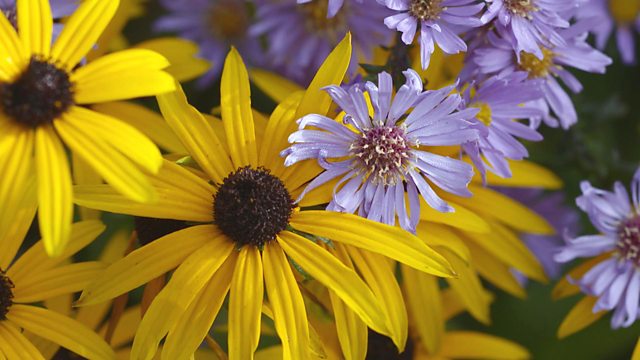
Episode 30
Gardening magazine. Monty Don cracks on with his seasonal tasks at Longmeadow. Carol Klein visits first-time gardeners Dan and Dominique as they prepare for winter.
As the days get shorter, it's a busy time in the garden. Monty Don cracks on with his seasonal tasks at Longmeadow, giving hints and tips along the way.
Carol Klein visits first-time gardeners Dan and Dominique for the very last time as they get their garden ready for winter.
And we catch up with Rachel de Thame's cut flower garden diary. It's July and her beds are flourishing.
Last on
Clips
-
![]()
Rachel’s cut flower diary (Part 3)
Duration: 06:00
-
![]()
Making Leaf Mould
Duration: 03:20
Moving small trees and shrubs
Any time from now until spring is the ideal time to move small trees and shrubs. There is always a risk in moving an established plant so here a few tips:
- The week before moving, ensure you have thoroughly watered your plant as moist roots transport much better and do not damage so easily.
- Evergreens are best moved either in October,Β November or March when the soil is warm and they can establish faster.
- For deciduous plants that can be moved at any time throughout the winter, the only time to avoid is when the ground is frozen.
- With a spade and a fork lightly investigate the root ball of the plant before lifting so you take as much root as possible -Β a good guide is to start just outside the spread of the branches.Β
- Now dig the plant out carefully, lifting as much of the root ball as you can and cutting any roots that can’t be dug out with secateurs. Then, if the root ball is large and heavy, slide the plant onto some sacking whichΒ can be secured around the main stem. Wrapping the rootsΒ will prevent damage while transporting the plantΒ to its new home.Β
- If the roots do sustain damage in the digging up or the move, prune the top of the plant back accordingly. This reduces the size of plant that the roots are trying to keep alive.Β
- For best results, replant immediately and water in very well. Back fill toΒ the to the original soil level the plant was growing in. If the plant is tall, stake well to prevent wind rock damaging the roots as the plant tries to establish itself.Β
- Finally, give the plant a really good mulch as this keeps the soil moist and will help the plant establish well, watering well in dry spells.
(www.rhs.org.uk)
Jobs for the weekend: Protect alpines from rain
If you grow alpine plants in pots, bowls or troughs they will need protection from winter rain, as they are used to dry but cold winters in the mountains where they originate. Simply move them out of the rain for the winter. Cold frames are ideal but if you don’t have one simply take a sheet of glass, balance and weigh it down on a couple of upturned pots and put your alpines underneath it.
(www.rhs.org.uk)
Jobs for the weekend: Cloche outdoor salad crops
If you are growing winter salad crops outside, now is the time to protect them with cloches.Β It is not only the cold but also the wind and rain you are protecting them from. The cloche will stop the leaves being damaged in storms. Simply place open-ended cloches over the plants and this will prolong your harvest of the leaves.
(www.rhs.org.uk)
Jobs for the weekend: Pot up amaryllis bulbs
Pot up amaryllis bulbs now and you will have blooms in the New Year. A top tip is to use a heavy, stable pot because the flowers can be top heavy when in full bloom. Using a free-draining compost mix, plant the bulbs leaving a third of the bulb showing. Water lightly and place somewhere warm and light -Β either in a heated greenhouse or a window sill in the home.
(www.rhs.org.uk)
Credits
| Role | Contributor |
|---|---|
| Presenter | Monty Don |
| Presenter | Carol Klein |
| Presenter | Rachel de Thame |
| Series Producer | Christina Nutter |
| Series Editor | Liz Rumbold |
Broadcasts
- Fri 24 Oct 2014 21:30Βι¶ΉΤΌΕΔ Two except Northern Ireland
- Sat 25 Oct 2014 18:30Βι¶ΉΤΌΕΔ Two except Wales
- Sun 26 Oct 2014 08:00
- Thu 6 Nov 2014 10:00


